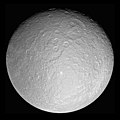Պատկեր:PIA07763 Rhea full globe5.jpg

Նախադիտման չափ՝ 600 × 600 պիքսել։ Այլ թույլտվությաններ: 240 × 240 պիքսել | 480 × 480 պիքսել | 768 × 768 պիքսել | 1024 × 1024 պիքսել | 2048 × 2048 պիքսել | 4920 × 4920 պիքսել.
Սկզբնական նիշք (4920 × 4920 փիքսել, նիշքի չափը՝ 2,67 ՄԲ, MIME-տեսակը՝ image/jpeg)
Նիշքի պատմություն
Մատնահարեք օրվան/ժամին՝ նիշքի այդ պահին տեսքը դիտելու համար։
| Օր/Ժամ | Մանրապատկեր | Օբյեկտի չափը | Մասնակից | Մեկնաբանություն | |
|---|---|---|---|---|---|
| ընթացիկ | 07:15, 27 Օգոստոսի 2018 |  | 4920 × 4920 (2,67 ՄԲ) | PlanetUser | Reverted to version as of 08:13, 13 March 2015 (UTC) |
| 10:09, 15 Օգոստոսի 2018 |  | 4920 × 4920 (2,66 ՄԲ) | The NMI User | Reverted to version as of 23:49, 14 August 2018 (UTC) | |
| 23:59, 14 Օգոստոսի 2018 |  | 4920 × 4920 (2,64 ՄԲ) | The NMI User | rv, fixed | |
| 23:49, 14 Օգոստոսի 2018 |  | 4920 × 4920 (2,66 ՄԲ) | The NMI User | Try making black | |
| 23:44, 14 Օգոստոսի 2018 |  | 4920 × 4920 (2,65 ՄԲ) | The NMI User | Fixed | |
| 08:09, 13 Օգոստոսի 2018 |  | 4920 × 4920 (3,67 ՄԲ) | The NMI User | Removing black borders | |
| 08:01, 13 Օգոստոսի 2018 |  | 4920 × 4920 (2,67 ՄԲ) | The NMI User | Reverted to version as of 08:13, 13 March 2015 (UTC) | |
| 07:56, 13 Օգոստոսի 2018 |  | 4920 × 4920 (5,67 ՄԲ) | The NMI User | Black background | |
| 08:13, 13 Մարտի 2015 |  | 4920 × 4920 (2,67 ՄԲ) | MoreTomorrow | making square (to match other planet/moon images) | |
| 06:43, 30 Հոկտեմբերի 2008 |  | 4920 × 4820 (2,68 ՄԲ) | WolfmanSF | This is the same full-resolution NASA image, with black panels added to the margins and some Photoshop processing to enhance contrast. |
Նիշքի օգտագործում
Հետևյալ 2 էջերը հղվում են այս նիշքին՝
Նիշքի համընդհանուր օգտագործում
Հետևյալ այլ վիքիները օգտագործում են այս նիշքը՝
- Օգտագործումը af.wikipedia.org կայքում
- Օգտագործումը ar.wikipedia.org կայքում
- قالب:المجموعة الشمسية
- قائمة أجرام المجموعة الشمسية مرتبة حسب الحجم
- قائمة أجرام النظام الشمسي المستديرة بالجاذبية
- قائمة الأقمار الطبيعية
- خط زمني لاكتشاف كواكب المجموعة الشمسية وأقمارها
- اكتشاف واستكشاف النظام الشمسي
- قائمة أنواع الكواكب
- بوابة:زحل/مقالة مختارة وصورة لأحد أقمار زحل
- قائمة أكبر الفوهات في المجموعة الشمسية
- 1981 ميداس
- Օգտագործումը ary.wikipedia.org կայքում
- Օգտագործումը arz.wikipedia.org կայքում
- Օգտագործումը ast.wikipedia.org կայքում
- Օգտագործումը as.wikipedia.org կայքում
- Օգտագործումը azb.wikipedia.org կայքում
- Օգտագործումը be.wikipedia.org կայքում
- Օգտագործումը bh.wikipedia.org կայքում
- Օգտագործումը ca.wikipedia.org կայքում
- Օգտագործումը ckb.wikipedia.org կայքում
- Օգտագործումը de.wikipedia.org կայքում
- Օգտագործումը el.wikipedia.org կայքում
- Օգտագործումը en.wikipedia.org կայքում
- Pioneer 11
- Rhea (moon)
- Cassini–Huygens
- Timeline of discovery of Solar System planets and their moons
- List of geological features on Rhea
- Naming of moons
- List of natural satellites
- List of gravitationally rounded objects of the Solar System
- Wikipedia:WikiProject Astronomy/Recognized content
- Portal:Solar System/Selected picture
- User:Dabomb87/Sandbox
- Tirawa (crater)
- Rings of Rhea
Տեսնել այս նիշքի ավելի համընդհանուր օգտագործումը:



